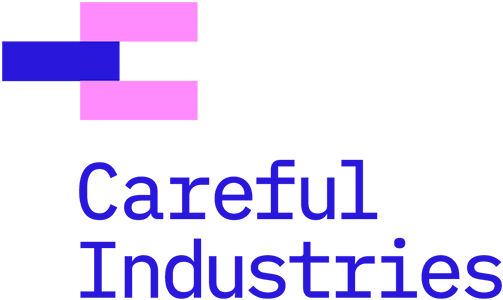The Networked Shift: A Creative Industries Foresight Study
At the end of 2022, Careful Industries was commissioned by the Creative Industries Policy and Evidence Centre, funded by the AHRC, and MyWorld to conduct a rapid foresight study, exploring some of the changes and challenges for the creative industries over the next three to five years. Published today, the report explores the impact of digital culture and technologies on the creative industries. As well as observing an overall shift to more networked, connected behaviours among audiences, creators, and digitally literate creative businesses, we identify three sticking points that create barriers to innovation. These sticking points are:
a lack of diversity and representation
uncertainty around automation
over-dependence on platform businesses
The Networked Shift is familiar to anyone who engages with digital culture: in the mainstream, it can be seen in the blurring of boundaries between genres, forms and business models that means a tech company like Apple can shift into TV commissioning, a streaming giant like Netflix can turn its hand to games, comedians can work with independent producers to turn podcasts into live sell-out tours, and YouTube influencers become creators of fast-moving consumer goods. These cross-cutting adaptations are the result of two decades of creative innovation and digital disintermediation, but — because they don’t align with existing definitions of R&D — they tend to play out without attracting much scrutiny.
The Networked Shift can also be seen in the ways that audiences are assembling into deep fandoms — rich, complex groups that would have once been seen as niches that are now highly profitable audiences, characterised by high levels of in-group identification, and often intensified by data-driven curation. Fans follow storyworlds and creators across platforms and media, from real life experiences to virtual reality, but these deep relationships are often not visible to other audience groups or to commissioners operating outside of networked culture.
This shift is, however, not absolute. Using Bill Sharpe’s Three Horizons framework, we also identified a number of sticking points - complex combinations of social, economic and technical conditions - that inhibit innovation for some established creative businesses, commissioners and institutions.
Three Horizons Model with sticking points, Bill Sharpe, H3Uni.org (2019)
These are:
1. The opportunity contradiction
The means to create and distribute creative content has been democratised by digital tools, platforms, and Internet connectivity – however the creative industries are not yet representative of the UK population. Our hypothesis is that this contradiction creates a possible future sticking point for workforce growth, driving diverse and under-served creators to become self-supporting, and that over time this approach to gatekeeping will limit both market reach and propensity to innovate.
2. The impact of automation on the Creative Industries
It seems probable that narratives about the potential impact of automation on the creative industries are (and will continue to be) heightened – but it is difficult to predict exactly how much.
Our findings suggest that overly optimistic predictions about the potential of automation to rapidly transform the creative industries do not give sufficient weight to frictions produced by the interaction of human, social, and economic factors. Automation will clearly have some impact on the creative industries in the coming five years, and there is a need for useful capabilities and infrastructures – such as better data, compute power, and copyright protections – to improve resilience and adaptability. The 'known unknown' in this case is the speed at which this change will occur.
3. Platform dependency in a post-lockdown world
Pandemic-era norms have yet to emerge which has made data-driven decision-making difficult for many creative businesses. Consumer behaviour in 2021 and 2022 is not a useful indicator for what might happen this year or next, and the strategic impact of this is being felt across many industries. For the creative industries, this uncertainty is increased by the propensity of platform businesses to pivot quickly in response to changing conditions. We examine the possible consequences of rapid pivots on media distribution and production.
The Networked Shift is far from perfect, but it seems likely this will shape the new paradigm for the creative industries - with adaptation by both indie creators and mega corporates shaping the new normal. Failure to address these sticking points might expedite the path of Horizon 1 and 2 organisations to becoming legacy gatekeepers, focussed on bringing models from the Twentieth Century to understand the business and behavioural patterns of the future.
Three Horizons Model with the Networked Shift, Bill Sharpe, H3Uni.org (2019)
To mitigate this, we recommend embracing the networked shift: rethinking the approach to silos and subsectors, and instead building cross-sector, multi-disciplinary networks that enable new skills and approaches to be shared and spread quickly. In particular, we recommend the creation of challenge-based networks that support rapid adaptation around emerging challenges, including:
Foresight and horizon scanning.
A shared capacity to observe and anticipate shifts and opportunities at the convergence of creativity, technology, and innovation, and develop approaches to measuring innovation that look beyond existing structures and siloes. To borrow a phrase from the US agency Intelligence Advanced Research Projects Activity (IARPA), this would help to 'mitigate technological surprise' and enable better forward planning to anticipate market shocks.
Emerging technology infrastructures.
Joined-up capabilities with the ability to focus on the kind of large-scale, cross-sector and multi-disciplinary problems that project-based innovation cannot support. Outputs might include the development of useful, high-quality data sets and the creation of new support structures to facilitate adaptation to the legal, ethical, and social challenges posed by emerging technologies. This kind of network could facilitate the incubation of copyright-management or payment technologies and the development of standards and principles to support the solutions to 'wicked problems' emerging around uses of technologies, including new legal precedents, to enable more equitable and rapid engagement with emerging technologies.
Workforce development.
Providing networks for lifelong retraining and skills development across the creative industries, at all levels of expertise, with a focus on solving the 'opportunity contradiction' we highlight in Section 2.1 as well as mitigating some of the workforce shocks we anticipate in Sections 2.2 and 2.3. This could offer training and reskilling that helps the creative workforce adapt to new technologies, facilitate human-machine interactions, and develop greater resilience in the face of changing business models.




